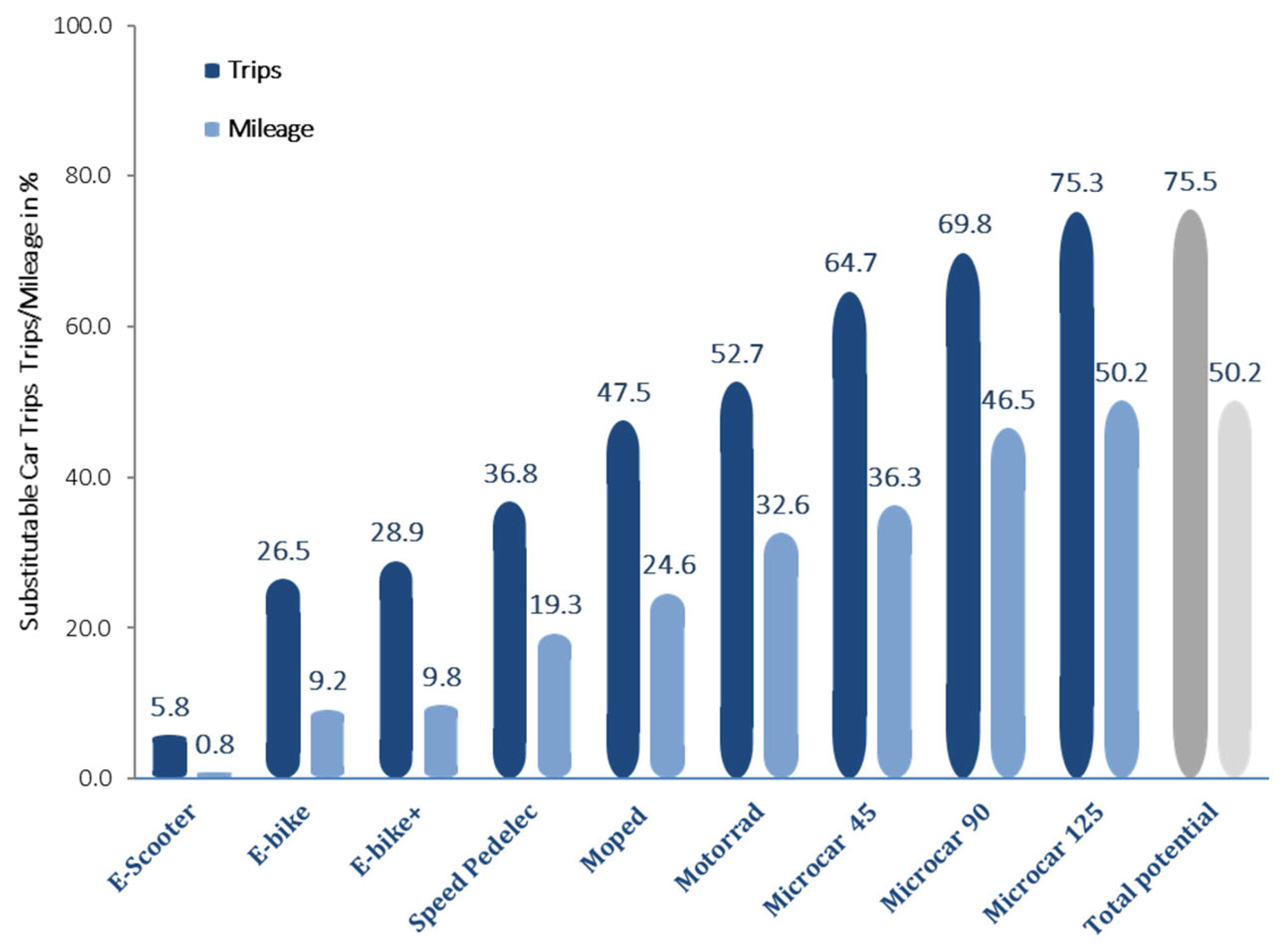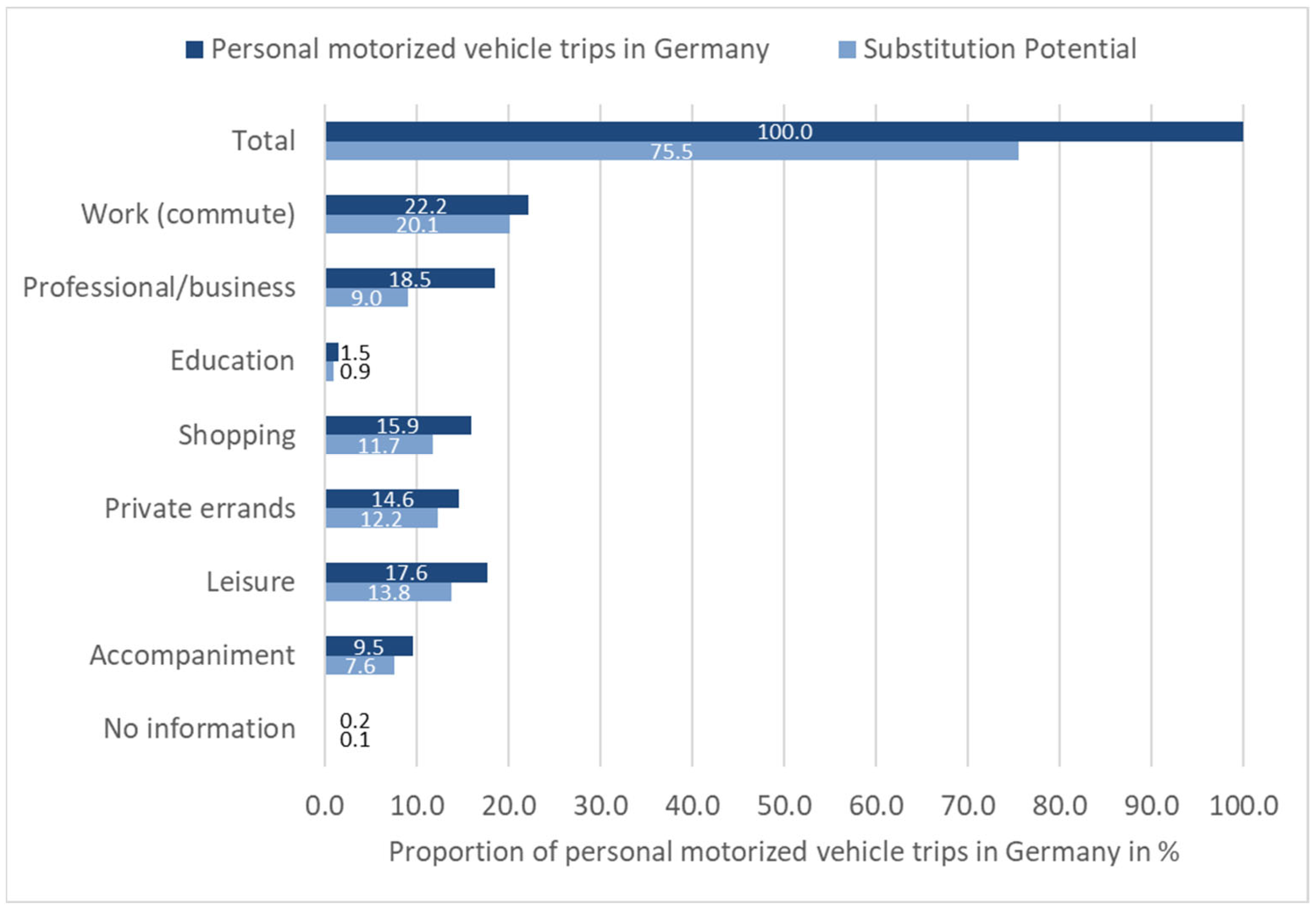What Potential Do Light Electric Vehicles Have to Reduce Car Trips?
Abstract
:1. Introduction
2. LEVs: Terminology and Considered Vehicles
3. Methodological Approach to Identify the Substitution Potential of LEVs
4. Results: Car Trip Substitution Potential
4.1. Trip Purposes
4.2. Age
5. Discussion: What Adjustments Could Be Made to Raise the Calculated Car Trip Substitution Potential?
5.1. Subject
5.2. Object
5.3. Context
6. Conclusions
Author Contributions
Funding
Institutional Review Board Statement
Informed Consent Statement
Data Availability Statement
Conflicts of Interest
Appendix A. LEV Parameters
| Exemplary LEV Model | E-Scooter | E-Bike | E-Bike+ | Speed Pedelec | Moped | Motorcycle | Microcar 45 | Microcar 90 | Microcar 125 |
|---|---|---|---|---|---|---|---|---|---|
| Max. speed [km/h] | 20 | 25 | 25 | 45 | 45 | 120 | 45 | 90 | 128 |
| Relevant travel distance: one way [km] | 4 | 15 | 15 | 30 | 30 | 45 | 40 | 70 | 70 |
| Relevant travel distance: round trip [km] | 8 | 30 | 30 | 60 | 60 | 90 | 80 | 140 | 140 |
| Number of occupants [no. of persons] | 1 | 1 | 1 + 3 kids (up to 7 years old) | 1 | 2 * | 2 * | 2 | 2 | 3 ** |
| Trip purposes [suitability] | All, with exceptions *** | ||||||||
| Street category | excl. highway | all | excl. highway | all | all | ||||
| Max. age of driver [years] | 70 | 99 | |||||||
| Weather conditions | all, without heavy rain, snowfall, or icy roads | all conditions | |||||||
| Impairments [suitability] | none | walking impairment | |||||||
References
- WBGU—Wissenschaftlicher Beirat der Bundesregierung Globale Umweltveränderungen. Der Umzug der Menschheit: Die Transformative Kraft der Städte, 2nd ed.; WBGU: Berlin, Germany, 2016; ISBN 978-3-936191-44-8. [Google Scholar]
- Husain, I.; Ozpineci, B.; Islam, M.S.; Gurpinar, E.; Su, G.-J.; Yu, W.; Chowdhury, S.; Xue, L.; Rahman, D.; Sahu, R. Electric Drive Technology Trends, Challenges, and Opportunities for Future Electric Vehicles. Proc. IEEE 2021, 109, 1039–1059. [Google Scholar] [CrossRef]
- Ewert, A.; Brost, M.; Schmid, S. Small Electric Vehicles—Benefits and Drawbacks for Sustainable Urban Development. In Small Electric Vehicles; Ewert, A., Schmid, S., Brost, M., Davies, H., Vinckx, L., Eds.; Springer International Publishing: Cham, Switzerland, 2021; pp. 3–15. ISBN 978-3-030-65842-7. [Google Scholar]
- Davies, H.; Bastien, C.; Nieuwenhuis, P.; Bailey, S. Challenges and Opportunities for Improving the Safety of Lightweight Vehicles. In Proceedings of the World Light Electric Vehicle Summit, Barcelona, Spain, 20–21 September 2016. [Google Scholar]
- Pavlovic, A.; Fragassa, C. General considerations on regulations and safety requirements for quadricycles. Int. J. Qual. Res. 2015, 9, 657–674. [Google Scholar]
- Ewert, A.; Schmid, S.; Brost, M.; Davies, H.; Vinckx, L. (Eds.) Small Electric Vehicles; Springer International Publishing: Cham, Switzerland, 2021; ISBN 978-3-030-65842-7. [Google Scholar]
- Liu, T.; Bogdanski, R. Light Electric Vehicles for a Green Transport Transition: Regulatory Approaches, Managerial Challenges and Market Potentials in Germany and China. Beijing. 2021. Available online: https://transition-china.org/wp-content/uploads/2021/12/20211203_Mikromobilitat_Broschure.pdf (accessed on 5 May 2023).
- Eisenmann, C.; Gruber, J.; Brost, M.; Ewert, A.; Stieler, S.; Gicklhorn, K. Fields of Applications and Transport-Related Potentials of Small Electric Vehicles in Germany. In Small Electric Vehicles; Ewert, A., Schmid, S., Brost, M., Davies, H., Vinckx, L., Eds.; Springer International Publishing: Cham, Switzerland, 2021; pp. 127–140. ISBN 978-3-030-65842-7. [Google Scholar]
- Brost, M.; Ewert, A.; Schmid, S.; Eisenmann, C.; Gruber, J.; Klauenberg, J.; Stieler, S. Elektrische Klein—Und Leichtfahrzeuge: Chancen und Potenziale für Baden-Württemberg. e-mobil BW GmbH—Landesagentur für neue Mobilitätslösungen und Automotive Baden-Württemberg: Stuttgart. 2019. Available online: https://www.e-mobilbw.de/fileadmin/media/e-mobilbw/Publikationen/Studien/LEV_e-mobil_BW_Leichtfahrzeug_Studie.pdf (accessed on 14 April 2023).
- BMVI. MiD 2017—Mobilität in Deutschland. Mikrodaten (Public Use File). Available online: https://daten.clearingstelle-verkehr.de/279/ (accessed on 17 April 2023).
- Brost, M.; Gebhardt, L.; Ehrenberger, S.; Dasgupta, I.; Hahn, R. The Potential of Light Electric Vehicles for Climate Protection through Substitution for Passenger Car Trips: Germany as a Case Study. Final Report, Berlin, Stuttgart. 2022. Available online: https://elib.dlr.de/186036/1/2022-03-24_LEV4Climate_DLR_LEVA-EU_report.pdf (accessed on 14 April 2023).
- Behrendt, F.; Heinen, E.; Brand, C.; Cairns, S.; Anable, J.; Azzouz, L. Conceptualizing Micromobility. Preprints.org 2022, 2022090386. [Google Scholar] [CrossRef]
- Rashid, A.A.A.; Abdullah, M.H. The Impact of Power Source to the Outline Design of a Kei-Car Segment. JEECIE 2016, 1, 20–24. [Google Scholar]
- Milakis, D.; Gebhardt, L.; Ehebrecht, D.; Lenz, B. Is micro-mobility sustainable? An overview of implications for accessibility, air pollution, safety, physical activity and subjective wellbeing. In Handbook of Sustainable Transport; Curtis, C., Ed.; Edward Elgar Publishing: Cheltenham, UK, 2020; pp. 180–189. ISBN 9781789900477. [Google Scholar]
- Regulation (EU) No 168/2013. On the approval and market surveillance of two- or three-wheel vehicles and quadricycles. Text with EEA relevance. Available online: https://eur-lex.europa.eu/LexUriServ/LexUriServ.do?uri=OJ:L:2013:060:0052:0128:en:PDF#:~:text=This%20Regulation%20establishes%20the%20requirements,and%20equipment%20for%20such%20vehicles. (accessed on 14 April 2023).
- Nobis, C.; Kuhnimhof, T. Mobilität in Deutschland—MiD Ergebnisbericht. In Studie von Infas, DLR, IVT und Infas 360 im Auftrag des Bundesministeriums für Verkehr und Digitale Infrastruktur; Bundesministerium für Verkehr und Digitale Infrastruktur: Bonn/Berlin, Germany, 2018; Available online: https://www.mobilitaet-in-deutschland.de/archive/pdf/MiD2017_Ergebnisbericht.pdf (accessed on 14 April 2023).
- Nobis, C.; Köhler, K. Mobilität in Deutschland—MiD Nutzerhandbuch. In Studie von Infas, DLR, IVT und Infas 360 im Auftrag des Bundesministeriums für Verkehr und Digitale Infrastruktur; Bundesministerium für Verkehr und Digitale Infrastruktur: Berlin, Germany, 2018; Available online: https://www.mobilitaet-in-deutschland.de/archive/pdf/MiD2017_Nutzerhandbuch.pdf (accessed on 14 April 2023).
- Ehrenberger, S.; Dasgupta, I.; Brost, M.; Gebhardt, L.; Seiffert, R. Potentials of Light Electric Vehicles for Climate Protection by Substituting Passenger Car Trips. World Electr. Veh. J. 2022, 13, 183. [Google Scholar] [CrossRef]
- Tack, A.; Klein, A.; Bock, B. E-Scooter in Deutschland. Ein Datenbasierter Debattenbeitrag. Available online: https://scooters.civity.de/ (accessed on 20 December 2022).
- t3n. E-Scooter: Wer Nutzt die Elektrischen Tretroller Eigentlich Wofür? Available online: https://t3n.de/news/e-scooter-nutzung-elektrische-tretroller-1171584/ (accessed on 20 December 2022).
- FOCUS online. Mobil für Touristen: Erste E-Scooter-Auswertung. Available online: https://www.focus.de/auto/news/erste-e-scooter-auswertung-mobil-fuer-touristen_id_10973682.html (accessed on 14 April 2023).
- Schenk, M. Medienwirkungsforschung, 3rd ed.; Mohr Siebeck: Tübingen, Germany, 2007; ISBN 978-3-16-149240-2. [Google Scholar]
- Zmud, J.P.; Sener, I.N. Towards an Understanding of the Travel Behavior Impact of Autonomous Vehicles. Transp. Res. Procedia 2017, 25, 2500–2519. [Google Scholar] [CrossRef]
- Watson, M. How theories of practice can inform transition to a decarbonised transport system. J. Transp. Geogr. 2012, 24, 488–496. [Google Scholar] [CrossRef] [Green Version]
- Fraedrich, E. How collective frames of orientation toward automobile practices provide hints for a future with autonomous vehicles. Appl. Mobilities 2018, 6, 253–272. [Google Scholar] [CrossRef]
- Fraedrich, E.; Lenz, B. Automated Driving: Individual and Social Aspects. Transp. Res. Rec. 2014, 2416, 64–72. [Google Scholar] [CrossRef]
- Lucke, D. Akzeptanz: Legitimität in der “Abstimmungsgesellschaft”; Leske + Budrich: Leverkusen, Germany, 1995; ISBN 978-3-663-09234-6. [Google Scholar]
- König, A.; Gebhardt, L.; Stark, K.; Schuppan, J. A Multi-Perspective Assessment of the Introduction of E-Scooter Sharing in Germany. Sustainability 2022, 14, 2639. [Google Scholar] [CrossRef]
- Ewert, A.; Brost, M.K.; Schmid, S.A. Framework Conditions and Potential Measures for Small Electric Vehicles on a Municipal Level. World Electr. Veh. J. 2020, 11, 1. [Google Scholar] [CrossRef] [Green Version]
- Mueller, N.; Rojas-Rueda, D.; Khreis, H.; Cirach, M.; Andrés, D.; Ballester, J.; Bartoll, X.; Daher, C.; Deluca, A.; Echave, C.; et al. Changing the urban design of cities for health: The superblock model. Environ. Int. 2020, 134, 105132. [Google Scholar] [CrossRef] [PubMed]
- CITIES Forum. Superblock (Superilla) Barcelona—A City Redefined. Available online: https://www.citiesforum.org/news/superblock-superilla-barcelona-a-city-redefined/ (accessed on 20 December 2022).
- E-Roller.com. JETZT Kommen die E-Scooter Parkplätze. Available online: https://e-roller.com/news/jetzt-kommen-die-e-scooter-parkplaetze/#:~:text=E%2DScooter%20Sharing%20Anbieter%20fluten,sodass%20sie%20den%20Weg%20versperren (accessed on 14 April 2023).
- 6t-Bureau de Recherche. Uses and Users of Free-floating Electric Scooters in France. 2019. Available online: https://www.mobilservice.ch/admin/data/files/news_section_file/file/4908/6t_trottinettes_synthese_eng.pdf?lm=1581430095 (accessed on 20 December 2022).
- Taylor, M.C.; Lynam, D.C.; Baruya, A. The Effect of Drivers’ Speed on the Frequency of Accidents; Transport Research Laboratory: Crowthome, UK, 2000. [Google Scholar]
- Nilsson, G. Traffic Safety Dimensions and the Power Model to Describe the Effect of Speed on Safety. Ph.D. Thesis, Lund University, Lund, Sweden, 2004. [Google Scholar]
- International Transport Forum. Speed and Crash Risk. Research Report. 2018. Available online: https://www.itf-oecd.org/sites/default/files/docs/speed-crash-risk.pdf (accessed on 21 April 2022).
- Gitelman, V.; Doveh, E.; Bekhor, S. The Relationship between Free-Flow Travel Speeds, Infrastructure Characteristics and Accidents, on Single-Carriageway Roads. Transp. Res. Procedia 2017, 25, 2026–2043. [Google Scholar] [CrossRef]
- Mitropoulos, L.; Kortsari, A.; Ayfantopoulou, G. A systematic literature review of ride-sharing platforms, user factors and barriers. Eur. Transp. Res. Rev. 2021, 13, 61. [Google Scholar] [CrossRef]
- Goralzik, A.; König, A.; Alčiauskaitė, L.; Hatzakis, T. Shared mobility services: An accessibility assessment from the perspective of people with disabilities. Eur. Transp. Res. Rev. 2022, 14, 34. [Google Scholar] [CrossRef]


| Category | Icon | Max. Speed in km/h | Number of Seats | Relevant Range * in km (Roundtrip) |
|---|---|---|---|---|
| E-Scooter |  | 20 | 0 (standing use) | 8 |
| E-bike |  | 25 | 1 | 30 |
| E-bike+ |  | 25 | 1 (+3 children) | 30 |
| Speed Pedelec |  | 45 | 1 | 60 |
| Moped |  | 45 | 2 | 60 |
| Motorcycle |  | 120 | 2 | 90 |
| Microcar 45 |  | 45 | 2 | 80 |
| Microcar 90 |  | 90 | 2 | 140 |
| Microcar 125 |  | 128 | 3 | 140 |
| Criteria | Exemplary Trip Reported in a Large-Scale National Mobility Survey in Germany (MiD 2017) | Scenario with E-Bike+ | Check |
|---|---|---|---|
| Trip length | 8 km (one way) | Up to 15 km (single trip), and up to 30 km for round trip | √ |
| Trip purpose | Commuting | All trip purposes, excluding the following:
| √ |
| Age (driver) | 59 | 18–70 years | √ |
| Weather | Snowfall | Without heavy rain, snowfall, or icy roads | x |
| Impairments | None | Only people without any health or mobility impairments | √ |
| Number of persons | 1 | 1 + 3 (only children up to 7 years old) | √ |
| Use of highways * | No highway use | Not suitable for highway use, as the maximum design speed is less than 60 km/h | √ |
| Age | Proportion of Personal Motorized Vehicle Trips | Substitution Potential |
|---|---|---|
| 0–9 | 0.5% | 0% |
| 10–19 | 2.4% | 58% |
| 20–29 | 11.6% | 80% |
| 30–39 | 16.7% | 74% |
| 40–49 | 22.0% | 75% |
| 50–59 | 23.0% | 74% |
| 60–69 | 13.3% | 77% |
| 70–79 | 8.2% | 82% |
| 80 and more | 2.1% | 81% |
| No information | 0.2% | 100% |
| Total | 100.0% | ----- |
Disclaimer/Publisher’s Note: The statements, opinions and data contained in all publications are solely those of the individual author(s) and contributor(s) and not of MDPI and/or the editor(s). MDPI and/or the editor(s) disclaim responsibility for any injury to people or property resulting from any ideas, methods, instructions or products referred to in the content. |
© 2023 by the authors. Licensee MDPI, Basel, Switzerland. This article is an open access article distributed under the terms and conditions of the Creative Commons Attribution (CC BY) license (https://creativecommons.org/licenses/by/4.0/).
Share and Cite
Gebhardt, L.; Brost, M.; Seiffert, R. What Potential Do Light Electric Vehicles Have to Reduce Car Trips? Future Transp. 2023, 3, 918-930. https://doi.org/10.3390/futuretransp3030051
Gebhardt L, Brost M, Seiffert R. What Potential Do Light Electric Vehicles Have to Reduce Car Trips? Future Transportation. 2023; 3(3):918-930. https://doi.org/10.3390/futuretransp3030051
Chicago/Turabian StyleGebhardt, Laura, Mascha Brost, and Robert Seiffert. 2023. "What Potential Do Light Electric Vehicles Have to Reduce Car Trips?" Future Transportation 3, no. 3: 918-930. https://doi.org/10.3390/futuretransp3030051
APA StyleGebhardt, L., Brost, M., & Seiffert, R. (2023). What Potential Do Light Electric Vehicles Have to Reduce Car Trips? Future Transportation, 3(3), 918-930. https://doi.org/10.3390/futuretransp3030051





